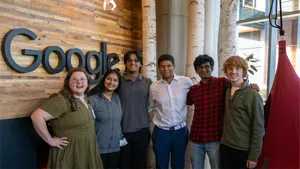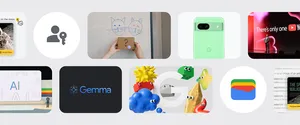The meaning of I/O: How Google's annual event got its name

Every spring for more than a decade, Googlers begin gearing up for I/O in May — but there’s an extra special buzz around the Shoreline Amphitheatre this year, because I/O 2023 marks the event’s fifteenth anniversary.
“I/O is representative of everything that Google has to offer for developers and beyond,” says Mike Pegg, who helped lead I/O on the marketing side from 2011 through 2017. “It’s when we share what we’re working on with the world, and we’ve had some incredible moments over the years, like when Android launched in 2008, or when support for HTML 5 was announced in 2011.”
Googlers — and the world — expect at least a little magic from I/O. But first, to properly celebrate 15 years, we wanted to do a deep dive on those two little letters at the center of it all: I.O.
Google I/O is our biggest event of the year. But where did the name originate?

A quick search will give you two commonly cited explanations: The first is that the name stands for “input / output,” referencing the computational concept of interfacing between a computer system and the outside world — a fitting idea for the conference given that it’s when we offer everyone a behind-the-scenes look at Google.
The second explanation you’ll see is that I/O stands for “innovation in the open,” which also lines up with the event nicely: It’s a day when we spotlight things like cutting-edge AI research, breakthrough accessibility features, next-generation products or even whole new ways to communicate with each other.
Both origins are true, but there’s more to the story. For that, we have to dig deeper into I/O’s history, all the way back to May 2006, when we held our first-ever developer conference, Geo Developer Day. It was centered around our first publicly available developer tool, the Google Maps API, which launched the previous year. With just 100 attendees, the event was held in the Googleplex on Google’s Mountain View campus and was a fraction of the size of today’s I/O events.
Flash forward a year and our suite of developer tools had expanded significantly — and we needed a bigger event to represent our products and engage with our growing developer community. Thus, I/O was born.
The current Google I/O logo, which debuted in 2013.

Except…it still wasn’t called I/O. “The very first ‘I/O’ in 2007 wasn’t called I/O at all,” says Lorin Platto, director of events and experiences operations and one of the original I/O event organizers. “It was an event called Google Developer Day, which we hosted at the San Jose Convention Center with 1,000 tickets for developers.” Google engineers and product experts presented sessions on developer tools at the convention center and at local events around the world from Sydney to São Paulo. “The San Jose event had only been open for an hour before it reached capacity. And that’s when we realized that the following year, we would need to really take this up a notch,” says Lorin.
In 2008, the event moved to a bigger venue — San Francisco's Moscone Center West — and with the move, got its official name.
The original I/O logo from 2008, with the connector-style design hinting at the “input/output” concept.

Originally, the name I/O was actually based on something numerical: a googol, the eponymous number that lends our company its name.
“A googol is a one, followed by 100 zeroes, so that's where the I/O name and logo came from. We just took the first one and zero, and we left off all the other zeroes. It all goes back to Google,” says Lorin. “And then as we were brainstorming, we started talking about what that one and zero could mean. That’s where the ‘input / output’ and ‘innovation in the open’ slogans came from.”
An (abbreviated) googol: the first two digits gave I/O its name.

The fact that I/O’s name origins are so complex is a feature, not a bug. After all, Easter eggs and hidden meanings are a long-running Google tradition. “From the beginning, we wanted it to resonate with the developer community,” says Lorin. “So the name Google I/O was almost like a puzzle to figure out.” (Those literal puzzles for developers to figure out the event date came later.)
“I/O really just means Google I/O now — it really embodies all of Google,” Mike adds. “It's grown to be more than a developer conference, it’s a great representation of everything we're doing and want to share with the world. When Sundar takes the stage, and says, ‘Good morning everyone, and welcome to Google I/O,’ it’s like, ‘ahhhh, we're here.’”
You can catch I/O this Wednesday, May 10. The pre-show starts at 9:30 a.m. PT, and the event kicks off with the Google Keynote at 10 a.m. PT.






